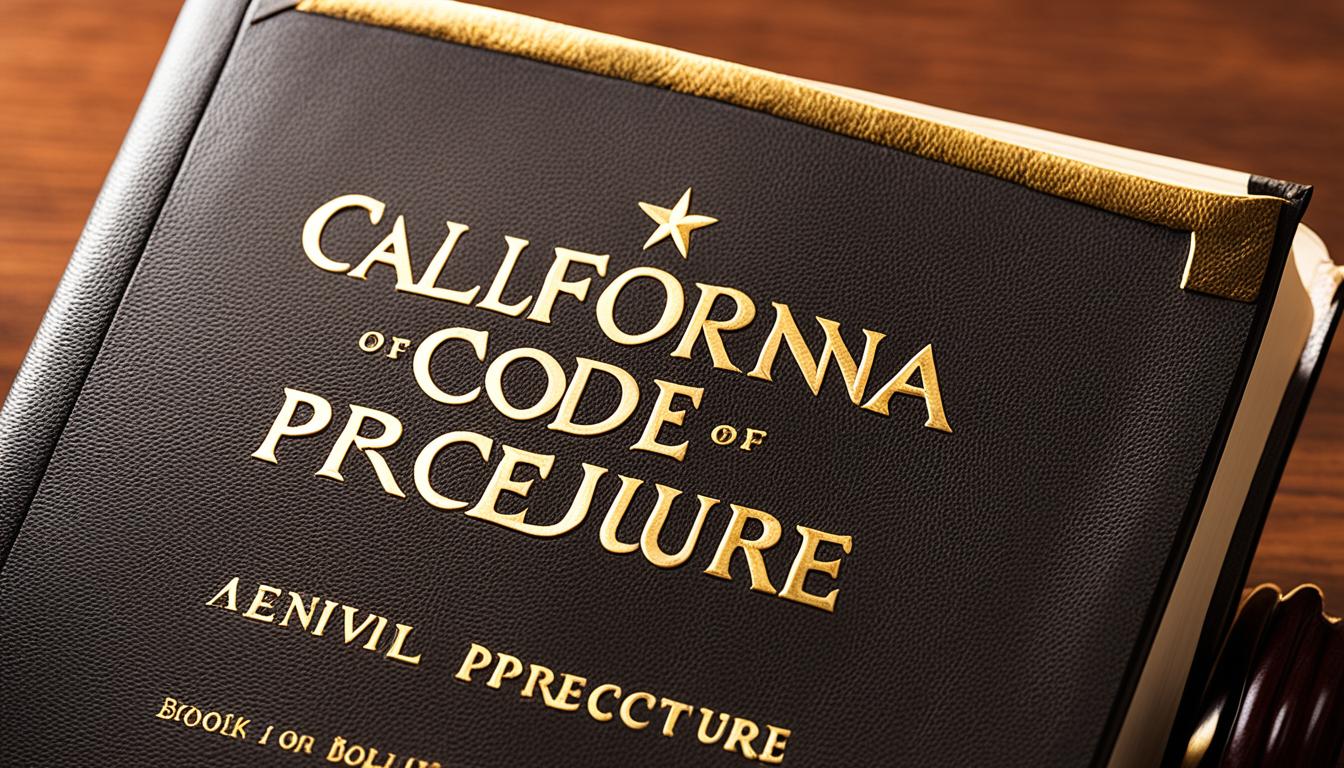The California Code of Civil Procedure (CCP) is a set of laws for civil cases in California. It covers court rules and legal steps. This guide will explain the CCP’s main parts, like court structure and roles of judges.
The CCP started in March 1872 and went into effect on January 1, 1873. It’s part of a group of laws that also include the Civil Code and Penal Code. The CCP is a “Field Code” state, meaning it covers trial court rules. Appellate procedure is mainly ruled by the California Rules of Court.
We will look into the California civil court system in this guide. We’ll see how it differs from federal rules. We’ll also talk about the state’s court system and how to navigate it.
Overview of California’s Civil Procedure System
California’s civil procedure system is different from the federal one. It’s important to know these differences to move through the state’s courts well. The California Code of Civil Procedure sets the rules for California courts. These rules are often different from the Federal Rules of Civil Procedure.
Key Differences from Federal Civil Procedure
A big difference is the time you have to start a civil trial in California. You must start a trial within five years of filing the first complaint. The federal system doesn’t have this rule. Also, how you file and answer motions, especially about discovery, can be different.
Importance of Understanding State Court Rules
Knowing the state’s rules is key to winning civil cases in California. The California Code of Civil Procedure has its own rules. For example, you might need to file more motions for different discovery responses. Not following these rules can hurt your case.
| Comparison | California Civil Procedure | Federal Civil Procedure |
|---|---|---|
| Time Limit to Bring Case to Trial | 5 years from filing of original complaint | No strict time limit |
| Discovery Motion Filing | Separate motions required for each type of discovery response | Single motion can cover multiple discovery issues |
| Pleading Paper Format | 28-line pleading paper, with specific formatting requirements | No standardized pleading paper format |
Knowing the differences between California’s civil procedure system and the federal civil procedure helps lawyers. They can move through the state’s courts better and follow the state court rules.
Jurisdiction and Organization of California Courts
The California court system is complex, with each court having its own role. At the heart are the Superior Courts, which handle many types of cases. These include civil and criminal cases, big or small.
For claims under $35,000, there’s the small claims court. This system is for individuals and businesses with smaller disputes.
Higher up, the California Courts of Appeal check if lower court decisions follow the law. These courts are split into six areas, each covering a certain region. The top court, the California Supreme Court, looks at appeals and big issues for the whole state.
| Court Type | Jurisdiction |
|---|---|
| Superior Courts |
|
| Courts of Appeal |
|
| California Supreme Court |
|
The California court system is set up to handle all kinds of legal issues. It makes sure California courts have the right jurisdiction and organization. This helps legal experts and citizens understand the system better.
“The California judicial system is a complex network of courts, each with its own distinct jurisdiction and responsibilities.”
Roles and Responsibilities of Judicial Officers
In California, judicial officers are key to a fair and efficient justice system. They include judges and magistrates. These people have many duties in the California courts.
Judges and Magistrates in California Courts
Judges in California handle trials, make decisions on motions, and keep the process fair. They follow the California Code of Judicial Ethics. This code sets out their duties and how they should act.
Magistrates help judges before trials start. They deal with things like setting court dates, discovery, and early motions. This helps make the court work better and gives judges a break.
- Judges can lead trials and decide on motions and evidence.
- Magistrates help with early stages, like setting court dates and dealing with motions.
- The California Code of Judicial Ethics tells judges how to act and what they must do.
Knowing what judicial officers do helps everyone understand the California court system better. It makes sure the process is fair and works well for everyone.
Persons with Judicial Powers in California
In California, people like judges and magistrates have special judicial powers. Referees, commissioners, and arbitrators also have these powers. They can do certain jobs in legal proceedings.
Referees are chosen by the court to decide on issues, take evidence, and suggest what to do next. Commissioners deal with cases that don’t need a full trial. They also handle some steps before and after a trial.
- Referees and commissioners can make writs, subpoenas, and other orders to do their jobs.
- Arbitrators are people who settle disputes outside of court. Their decisions are usually final for the people involved.
These people and groups are key to making sure justice is done quickly in California. They help by sharing their knowledge and skills. This helps the courts work better and makes sure justice is served fast and well.

“The court can make people follow its decisions, orders, and its process. It can also change its process to fit the law and justice.”
Court Ministerial Officers and Their Duties
The California courts depend a lot on court ministerial officers. They make sure the courts work well. These people do important tasks that help the legal process.
The court clerk is one of these officers. They keep track of court records, set up hearings, and handle legal papers. They make sure all case details are correct and easy to find.
Then there’s the court reporter. They write down what happens in court. These records are important for looking back or appealing a decision. Court reporters in California are key to making sure these records are right.
Bailiffs also work as court officers. They keep the courtroom safe and in order. They help judges, take care of defendants, and make sure everyone follows the rules.
| Court Ministerial Officer | Key Duties |
|---|---|
| Court Clerk | – Maintain court records – Schedule hearings – Process legal documents |
| Court Reporter | – Transcribe courtroom proceedings – Provide official record of events |
| Bailiff | – Maintain order and security in the courtroom – Assist judges and escort defendants |
Court ministerial officers are key to helping California courts work well. They make sure justice is served smoothly. Their hard work and focus are crucial for a fair legal system.
“The California Code of Civil Procedure outlines the specific duties and responsibilities of court ministerial officers, emphasizing their crucial contribution to the efficient functioning of our state’s judicial system.”
Pretrial Procedures in California Civil Cases
In California, the Code of Civil Procedure sets out the rules for pretrial procedures in civil cases. It covers how to file complaints, serve defendants, and answer lawsuits. It also talks about the discovery process and how to produce documents and evidence before trial.
Filing Complaints and Responding to Lawsuits
The Judicial Council in California can make rules for pretrial conferences in civil cases. Superior court judges can also make local rules to speed up court work. These rules must get a yes from most judges, be shared with the local bar, and officially adopted before being sent to the Judicial Council for review.
Local rules can have penalties like striking out pleadings or entering default judgment. But, these penalties must warn the affected party and give them a chance to speak. If the problem is the lawyer’s fault, the penalty should only affect the lawyer, not the case.
Discovery Rules and Document Production
California has rules for the discovery process in civil cases. Parties must share proposed exhibits four weeks before trial. They also have an exhibit conference three weeks before trial to look at trial exhibits.
One week before trial, parties must file their Exhibit List and give pre-marked exhibits. Each party needs to prepare at least three sets of exhibits.
| Exhibit Marking | Requirement |
|---|---|
| Joint exhibits | Pre-marked with the designation “J-[Number]” |
| Plaintiff’s exhibits | Pre-marked using numbers starting with 1 |
| Defendant’s exhibits | Pre-marked with letters starting with A |
Parties can admit discovery responses as evidence. Deposition testimony must be marked by page and line number and filed three weeks before trial.
The California civil procedure guide gives detailed advice and checklists for pretrial matters. It helps California lawyers understand and work more efficiently.
California Code of Civil Procedure
The California Code of Civil Procedure (CCP) is a set of laws for civil lawsuits and court rules in the state. It started in March 1872, building on the Practice Act of 1851. This was inspired by the New York Code of Civil Procedure of 1850. California is a “Field Code” state, meaning the CCP rules how lawsuits are filed and handled in Superior Courts.
The CCP defines important terms like “action,” “complaint,” “court,” “defendant,” and “plaintiff.” It sets limits on when a lawsuit can start. It also talks about waiver and estoppel, and when a court can dismiss a case or use sanctions.
Section 583.130 of the CCP talks about making sure lawsuits move forward. It stresses the need for everyone to work together to get a case to trial. The code also touched on the law of evidence, which was later replaced by the California Evidence Code.
| Provision | Description |
|---|---|
| Section 583.161 | Specifies conditions under which a petition filed according to Family Code Section 2330 should not be dismissed, such as if child support or spousal support orders have not been terminated. |
| Section 583.140 | Clarifies that the California Code of Civil Procedure does not abrogate or affect the principles of waiver and estoppel. |
| Section 583.150 | Provides guidelines for a motion of dismissal in an action commenced before, on, or after the effective date of the chapter, with specific provisions for cases initiated before the effective date. |
Section 1209 of the CCP lists acts or omissions that are contempt of court. These include things like disorderly conduct, neglect of duty, and disobeying court orders.
The California Code of Civil Procedure is key to the state’s civil justice system. It sets the rules for filing and handling lawsuits in Superior Courts.
Trial Practices and Evidentiary Rules
The California Code of Civil Procedure sets the rules for trials in the state’s courts. It covers how to present evidence, question witnesses, and what evidence is allowed in court.
Admissibility of Evidence in California Courts
California has its own rules for what evidence can be used in court. These rules are different from the federal rules. Lawyers must know these rules to use things like documents, objects, and witness stories in court. Whether evidence is allowed in court is very important for a case’s strength.
| Evidentiary Rules | Key Considerations |
|---|---|
| Authentication | Showing where evidence came from and if it’s real |
| Hearsay | Finding ways to use statements made outside court |
| Expert Testimony | Checking if expert witnesses and their opinions are allowed |
| Character Evidence | Learning when you can use evidence about someone’s character |
It’s very important for lawyers to know California’s rules about evidence. This knowledge helps them present strong cases in court.

“The admissibility of evidence is a critical aspect of trial practices in California, as it can directly impact the strength and persuasiveness of a case.”
Post-Trial Remedies and Appeals Process
The California Code of Civil Procedure has rules for post-trial remedies and appeals. A key motion is for judgment notwithstanding the verdict (JNOV). This lets the court make a new judgment if the trial evidence was not enough.
There’s also a motion for a new trial. You can ask for this if there were mistakes in the trial, juror mistakes, new evidence, or errors in law. You must follow certain rules and deadlines for these motions. If you don’t, your motion might not work in the appeals court.
Appeals in California give people a chance to challenge the trial court’s decisions. But, there are rules. For example, filing an appeal before a JNOV motion can cause problems. The court has limited time to decide on these motions, with specific deadlines for filing and getting a decision.
| Post-Trial Motion | Timeline |
|---|---|
| Motion for JNOV | Must be filed within 15 days after the service of notice of entry of judgment |
| Motion for New Trial | Must be filed within 15 days after the service of notice of entry of judgment |
Knowing about post-trial remedies and appeals process in California civil procedure is key. It helps litigants navigate the legal system and protect their rights after a trial.
“Failure to follow proper procedures when submitting posttrial motions can result in automatic denial or render the motion ineffective in the appellate court.”
Comparison with Federal Rules of Civil Procedure
The California Code of Civil Procedure has some things in common with the federal rules of civil procedure. Yet, there are big differences too. This part will look at both sides to help you understand California’s civil court system better.
Key Similarities and Differences Explained
California and federal courts can handle certain types of cases. But, California courts can deal with many more kinds of cases. Federal courts mainly work with cases about the U.S. government, breaking federal laws, cases from different states, and special areas like bankruptcy and copyright. On the other hand, California state courts handle a wide variety of civil disputes.
Another big difference is how they look at claims. Federal courts need claims to be very specific to not get thrown out. California state courts make it easier to start a lawsuit.
| Comparison Point | Federal Rules | California Code of Civil Procedure |
|---|---|---|
| Jurisdiction Scope | Limited to specific federal matters | Broader range of civil disputes |
| Pleading Standards | More specific allegations required | Lower threshold for initiating a lawsuit |
| Discovery Rules | Parties must disclose facts before formal discovery | Discovery can commence earlier than federal rules |
| Interrogatories | Limited to 25 as a matter of right | Allows up to 35 interrogatories as a matter of right |
| Judicial Challenges | No statutory procedure for peremptory challenges | Code of Civil Procedure section 170.6 allows peremptory challenges of judges |
California and federal courts also differ in how they handle discovery. In California, you can start discovery earlier than in federal courts. This means e-discovery issues can come up sooner in California cases.
Even though California and federal courts share some things, knowing the main differences is key. Lawyers often charge more for federal court cases because they’re harder. Sometimes, filing in federal court might be better than in state court.
Resources for Further Study of California Civil Procedure
For a deeper look into California’s civil procedure, many resources are available. Legal books, online databases, and other trusted sources are great for those interested. They help with understanding the complex rules of civil procedure in California.
The Sacramento County Public Law Library gives a detailed look at California’s statutes of limitations. It shows the time limits for different civil cases. It also explains how these limits start, end, and can be paused in some cases.
For more detailed information, legal experts and researchers can look at certain books. These include California Forms of Pleading and Practice, California Points and Authorities, and Civil Procedure Before Trial (CEB – One Volume). These books go deep into civil procedure. They offer advice on pleadings, motions, discovery, and other key parts of the legal process.

